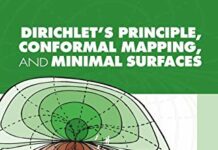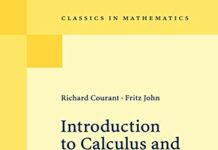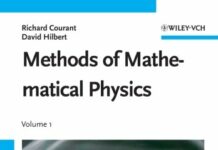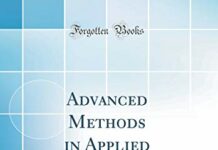
Ebook Info
- Published: 1999
- Number of pages: 684 pages
- Format: PDF
- File Size: 52.43 MB
- Authors: Richard Courant
Description
From the Preface: (…) The book is addressed to students on various levels, to mathematicians, scientists, engineers. It does not pretend to make the subject easy by glossing over difficulties, but rather tries to help the genuinely interested reader by throwing light on the interconnections and purposes of the whole. Instead of obstructing the access to the wealth of facts by lengthy discussions of a fundamental nature we have sometimes postponed such discussions to appendices in the various chapters. Numerous examples and problems are given at the end of various chapters. Some are challenging, some are even difficult; most of them supplement the material in the text.
User’s Reviews
Editorial Reviews: Review From the reviews: “Volume 1 covers a basic course in real analysis of one variable and Fourier series. It is well-illustrated, well-motivated and very well-provided with a multitude of unusually useful and accessible exercises. […]It is the best text known to the reviewer for anyone trying to make an analysis course less abstract.” –The Mathematical Gazette About the Author Biography of Richard CourantRichard Courant was born in 1888 in a small town of what is now Poland, and died in New Rochelle, N.Y. in 1972. He received his doctorate from the legendary David Hilbert in Göttingen, where later he founded and directed its famed mathematics Institute, a Mecca for mathematicians in the twenties. In 1933 the Nazi government dismissed Courant for being Jewish, and he emigrated to the United States. He found, in New York, what he called “a reservoir of talent” to be tapped. He built, at New York University, a new mathematical Sciences Institute that shares the philosophy of its illustrious predecessor and rivals it in worldwide influence. For Courant mathematics was an adventure, with applications forming a vital part. This spirit is reflected in his books, in particular in his influential calculus text, revised in collaboration with his brilliant younger colleague, Fritz John. (P.D. Lax)Biography of Fritz JohnFritz John was born on June 14, 1910, in Berlin. After his school years in Danzig (now Gdansk, Poland), he studied in Göttingen and received his doctorate in 1933, just when the Nazi regime came to power. As he was half-Jewish and his bride Aryan, he had to flee Germany in 1934. After a year in Cambridge, UK, he accepted a position at the University of Kentucky, and in 1946 joined Courant, Friedrichs and Stoker in building up New York University the institute that later became the Courant Institute of Mathematical Sciences. He remained there until his death in New Rochelle on February 10, 1994. John’s research and the books he wrote had a strong impact on the development of many fields of mathematics, foremost in partial differential equations. He also worked on Radon transforms, illposed problems, convex geometry, numerical analysis, elasticity theory. In connection with his work in latter field, he and Nirenberg introduced the space of the BMO-functions (bounded mean oscillations). Fritz John’s work exemplifies the unity of mathematics as well as its elegance and its beauty. (J. Moser)
Reviews from Amazon users which were colected at the time this book was published on the website:
⭐If you ask a mathematician to recommend you a good, rigorous calculus text, chances are you will hear the names Spivak, Apostol, and Courant more than any other. The single-volume “Calculus” by Spivak, the two-volume “Calculus” by Apostol, and the two-volume “Introduction to Calculus and Analysis” by Courant (now sold in three volumes due to the length of volume II including solutions) are each excellent in their own way. All of them are considerably more rigorous than the typical undergraduate calculus book and require some serious effort to get through.I have read both Spivak and Courant and at one time owned a copy of Apostol and used it as a supplement, although I never studied it carefully. I will let wiser heads than mine decide which of the three is best suited for the student interested in pure mathematics, applied mathematics, or physics. I will just note that the two-volume Apostol and Courant cover significantly more material that the one-volume Spivak, and also include many more applications than Spivak. (Of course, showing applications was not Spivak’s intent, and there are other books for that.)I personally found Courant the most difficult of the three, but also the most rewarding. Like other reviewers have said, Courant somehow provides a perfect synergy of rigor, intuition, and motivation. He assumes that the reader is intelligent, interested, and willing to work. He provides plenty of proofs, but he takes time to comment on the “why?” as well as the “how?” His two volumes succeed both as a reasonably comprehensive introduction to single- and multi-variable calculus (with a healthy dose of analysis added in for good measure), and as a solid introduction to mathematical physics.I will just echo the other reviewers who recommend that anyone reading Volume I of Courant track down Albert Blank’s “Problems in Calculus and Analysis.” The Spanish-language version of Blank’s book (“Problemas de Calculo y Analisis Matematico del Courant”) is still available on Amazon and is accessible to anyone with some rudimentary Spanish and a decent Spanish dictionary. It may also be possible to find a copy of the English version online. Blank’s supplement is very useful for several reasons. First, it contains hundreds of exercises in addition to the problems found in Volume I itself. Counting both the problems in Volume 1 (which are repeated in Blank’s book) and the new exercises in Blank’s book, there are over 900 in total. The vast majority of them have either solutions or strong hints provided. The additional exercises in Blank’s book are often – but not always – somewhat easier than the problems in Volumes 1.Second, some of the problems in Volume I are quite difficult. As difficult (or even more so) than the most difficult problems in Spivak, which itself is known for its challenging problems. If the reader is going through Courant by himself/herself (and I suspect that few universities teach directly out of Courant these days; it is probably considered too challenging for the modern undergraduate course), having the solutions available to some of the more difficult problems is nearly essential.Overall, I think Courant fully deserves its place in the triumvirate of outstanding calculus books, and will richly reward an attentive reader.
⭐Excellent. The book came in great condition and it’s content is fantastic. It provides a far greater scope to many topics in calculus 2, ones that are omitted or negated due to “rigor” or unnecessary need. As someone deeply interested in physics, it’s very nice that Courant ties in so many physics applications and their phenomenologies.
⭐Excellent reference for both calculus and undergrad-level analysis. Will replace a few books in my library. The writing style is crystal clear and orients all exposition to applications and intuition, as every math textbook should.
⭐For people taking a very rigorous calculus course or an introductory Analysis course, this is a good book. Very dense and wordy, but a classic and entirely understandable given enough time.
⭐Arrived quite timely! Perfect conditions.
⭐This (and Vol. 2) are both really good books that anyone with an interest in mathematics should own. Is it as good as Apostol’s two volumes (Tommy I and II)? No. Is it as good as Spivak’s “Calculus”? No. But it is still very good because the exposition is wonderful. I own both volumes and am glad – but if you only want one Courant book, please buy “What is Mathematics”.
⭐classic
⭐I absolutely love this book. I found myself having to retake the calculus courses for engineers and physicists in the French system. Though I had a math degree and had continued doing math as a hobby, there were elements of my calculus courses that still haunted me. I decided not to use the teacher’s notes and instead used this book mainly because of the reviews here.On the pedagogical organization of this book, it is peerless in our modern age of calculus books that can serve as no more than doorstops after the courses are finished. The exposition switches between theorems, examples, and graphical support in a way that really supports future learning. One is equally prepared for future mathematical studies as a mathematician, physicist, or engineer. The approach of using basic definitions of both integrals and derivatives to create a library of building block derivatives and integrals gives one a concrete sense of where these animals come from before using them in more sophisticated problems. And doing integrals before derivatives? This makes so much sense to me after doing it that way. There was a basic literacy incalculations that I was missing, and this book fixed it right up.Two sidenotes:(1) I give it 4-stars because the solution manual is so hard to find.(2) I really READ this book. That is, I did not move on to the next sentence until I felt like I fully grasped what the current sentence was saying and why. If there was a calculation I did not follow, I stayed there until I could do it myself. That is how I got to experience a slice of Courant’s pedagogical vision.
⭐Probablemente el mejor texto d cálculo diferencial dl siglo XX.Goursat, Vallee Poussin, quizá Apóstol (más moderno)Spivak sólo cubre una variable y sin aplicaciones d física o geometría.Para muy buenos estudiantes d matemáticas y ciencias e ingeniería.Añadiendo algo d variable compleja (Markusevich, edita AMS) están todas las matemáticas clásicas d una ingenieríaA different approach to teach calculus. Instead of using a pedagogically simple format, this book tutors you in a logically correct way. Great book for students learning calculus for first time.
⭐book quality of jyoti book is very poor
Keywords
Free Download Introduction to Calculus and Analysis, Vol. 1 (Classics in Mathematics) 1999th Edition in PDF format
Introduction to Calculus and Analysis, Vol. 1 (Classics in Mathematics) 1999th Edition PDF Free Download
Download Introduction to Calculus and Analysis, Vol. 1 (Classics in Mathematics) 1999th Edition 1999 PDF Free
Introduction to Calculus and Analysis, Vol. 1 (Classics in Mathematics) 1999th Edition 1999 PDF Free Download
Download Introduction to Calculus and Analysis, Vol. 1 (Classics in Mathematics) 1999th Edition PDF
Free Download Ebook Introduction to Calculus and Analysis, Vol. 1 (Classics in Mathematics) 1999th Edition





